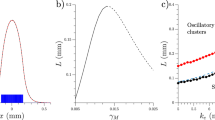Abstract
Myxobacteria exhibit a complex life cycle characterized by a sequence of cell patterns that culminate in the formation of three-dimensional fruiting bodies. This paper provides indications that the specific cell shape of myxobacteria might play an important role in the different morphogenetic processes during the life cycle. We introduce a new mechanism for collective migration that can explain the formation of aligned cell clusters in myxobacteria. This mechanism does not depend on cell cooperation, and in particular it does not depend on diffusive signals guiding cell motion.
A Cellular Potts Model (CPM) that captures the rod cell shape, cell stiffness and active motion of myxobacteria is presented. By means of numerical simulations of model cell populations where cells interact via volume exclusion, we provide evidence of a purely mechanical mechanism for collective migration, which is controlled by the cells' length-to-width aspect ratio.
Similar content being viewed by others
References
M. Alber, M. Kiskowski and Y. Jiang, Lattice gas cellular automaton model for rippling and aggregation in myxobacteria. Physica D 191:343–358 (2004).
U. Börner, A. Deutsch, H. Reichenbach and M. Bär, Rippling patterns in aggregates of myxobacteria arise from cell-cell collisions. Phys. Rev. Lett. 89:078101 (2002).
J. H. Bussemarker, A. Deutsch and E. Geigant, Mean-field analysis of a dynamical phase transition in a cellular automaton model for collective motion. Phys. Rev. Lett. 78:5018–5021 (1997).
A. Deutsch and S. Dormann, Cellular automaton modeling of biological pattern formation - characterization, applications, and analysis. Birkhauser, Boston (2005).
M. Dworkin and D. Kaiser, Myxobacteria II. American Society for Microbiology (1993).
F. Graner and J. A. Glazier, Simulation of biological cell sorting using a two-dimensional extended Potts model. Phys. Rev. Lett. 69:2013–2016 (1992).
O. Igoshin, A. Mogilner, R. D. Welch, K. Dale and G. Oster, Pattern formation and traveling waves in myxobacteria: Theory and modeling. Proc. Natl. Acad. Sci. U.S.A. 98:14913–14918 (2001).
O. A. Igoshin, R. Welch, D. Kaiser and G. Oster, Waves and aggregation patterns in myxobacteria. Proc. Natl. Acad. Sci. U.S.A. 101:4256–4261 (2004).
L. Jelsbak and L. Søgaard-Andersen, Pattern formation by a cell surface-associated morphogen in Myxococcus xanthus. Proc. Natl. Acad. Sci. U.S.A. 99:2032–2037 (2002).
D. Kaiser, Coupling cell movement to multicellular development in myxobacteria. Nat. Rev. Microbiol. 1:45–54 (2003).
D. Kaiser and C. Crosby, Cell movement and its coordination in swarms of Myxococcus xanthus. Cell. Motil. Cytoskeleton 3:227–245 (1983).
D. Kaiser and R. Yu, Reversing cell polarity: Evidence and hypothesis. Curr. Opin. Microbiol. 8:216–221 (2005).
R. Merks, J. Glazier, S. Brodsky, M. Goligorksy and S. Newman, Cell elongation is key to in silico replication of in vitro vasculogenesis and subsequent remodeling. Dev. Biol. 289:44–54 (2006).
A. Mogilner and L. Edelstein-Keshet, Spatio-angular order in populations of self-aligning objects: formation of oriented patches. Physica D 89:346–367 (1996).
H. Othmer and P. Schaap, Oscillatory cAMP signaling in the development of Dictyostelium discoideum. Comments Theor. Biol. 5:175–282 (1998).
F. Peruani, A. Deutsch and M. Br, Non-equilibrium clustering of self-propelled rods. Phys. Rev. E 74:030904 (2006).
A. M. Rodriguez and A. M. Spormann, Genetic and molecular analysis of cglb, a gene essential for single-cell gliding in Myxococcus xanthus. J. Bacteriol. 181:4381–390 (1999).
L. Søgaard-Andersen, Cell polarity, intercellular signalling and morphogenetic cell movements in Myxococcus xanthus. Curr. Opin. Microbiol. 7:587–593 (2004).
W. Shi and D. R. Zusman, The two motility systems of Myxococcus xanthus show different selective advantages on various surfaces. Proc. Natl. Acad. Sci. U.S.A. 90:3378–3382 (1993).
A. M. Spormann and D. Kaiser, Gliding movements in Myxococcus xanthus. J. Bacteriol. 177:5846–5852 (1995).
A. Stevens, A stochastic cellular automaton modeling gliding and aggregation of myxobacteria. SIAM J. Appl. Math. 61:172–182 (2000).
H. Sun, Z. Yang and W. Shi, Effect of cellular filamentation on adventurous and social gliding motility of Myxococcus xanthus. Proc. Nat. Acad. Sci. U.S.A. 96:15178–15783 (1999).
T. Vicsek, A. Czirók, E. Ben-Jacob, I. Cohen and O. Shochet, Novel type of phase transition in a system of self-driven particles. Phys. Rev. Lett. 75:1226–1229 (1995).
R. Welch and D. Kaiser, Cell behavior in traveling wave patterns of myxobacteria. Proc. Natl. Acad. Sci. U.S.A. 98:14907–14912 (2001).
Author information
Authors and Affiliations
Corresponding author
Rights and permissions
About this article
Cite this article
Starruß, J., Bley, T., Søgaard-Andersen, L. et al. A New Mechanism for Collective Migration in Myxococcus xanthus . J Stat Phys 128, 269–286 (2007). https://doi.org/10.1007/s10955-007-9298-9
Received:
Accepted:
Published:
Issue Date:
DOI: https://doi.org/10.1007/s10955-007-9298-9




